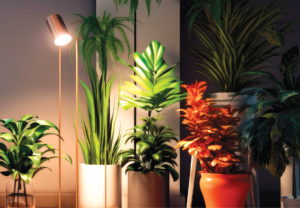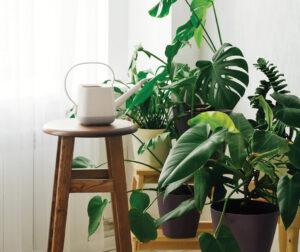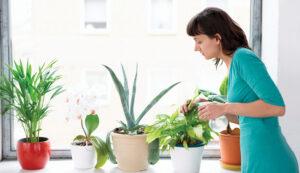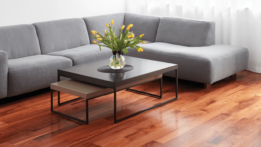 I used to kill every indoor plant I tried to keep. I would water them regularly, pot them with nutritious soil, and place them by my bedroom window. They died every time. Then, I learned that it is not enough to carelessly set your plants on a windowsill and assume they have enough light. In fact, there are many factors you have to keep in mind when positioning your indoor plant for the perfect lighting, including the distance from the window, the direction of the window, and the artificial lights in your home. If you are as clueless as I was about the proper lighting for your indoor plants, this article will explain what you need to know to help them thrive.
I used to kill every indoor plant I tried to keep. I would water them regularly, pot them with nutritious soil, and place them by my bedroom window. They died every time. Then, I learned that it is not enough to carelessly set your plants on a windowsill and assume they have enough light. In fact, there are many factors you have to keep in mind when positioning your indoor plant for the perfect lighting, including the distance from the window, the direction of the window, and the artificial lights in your home. If you are as clueless as I was about the proper lighting for your indoor plants, this article will explain what you need to know to help them thrive.
As you likely know, plants require light for energy and to produce chlorophyll, the pigment that makes them appear lush and green. When a plant is not getting enough sunlight, it may start turning pale green, yellow, or white. Other signs your plant is not getting enough light include dropping leaves, a lack of buds in flowering plants, or abnormal growth. If there are long stretches of stem between each leaf node, your plant has grown pressed up against the window, or the stems appear unusually long and thin, it is a sign your plant is searching for more light.
Different types of plants will need various amounts of light in order to thrive. The right lighting for a cactus can cause a peace lily to shrivel and die. Do some research into what kind of light your species of plants prefer, but generally, there are three categories: low light, medium light, and high light. Large-leafed house plants, like snake plants, typically prefer low light. Ferns, ficus, and ivy usually enjoy medium light; and palms, herbs, and succulents need high amounts of light. Plant lighting is also measured in three aspects: intensity, duration, and quality.
Intensity
Intensity refers to how strong a light is, its brightness, and the plant’s distance from the light source. In artificial lights like LEDs, this is measured in lumens, but the intensity of natural light depends on shade levels. If sunlight is coming straight through your window and onto the plant, it is direct light. If the light is partially blocked by curtains, dappled by tree boughs, or shaded, it is indirect. If you have a plant that needs high intense light, place it close to the window. If your plant is prone to overheating, consider moving it further from the window or using a translucent curtain to soften the direct light.
Duration
Duration refers to the number of hours per day of direct or indirect sunlight your plant receives. As the sun passes by your window, the angle of the light will change throughout the day, meaning if your plant is in direct sunlight in the morning, it may be in indirect lighting by the afternoon. You can observe your plant throughout the day to measure the duration of direct light it receives or calculate it based on the position of the sun, the angle of your window, and which direction your window is facing. Depending on the season, your plants will get more or less hours of sunlight, but generally a south facing window offers the most light while a north facing window offers the least. East facing windows will have bright light in the morning while west facing windows will receive bright light in the afternoon. If your plant needs more light, try to place it at an angle between east and west so it gets the most possible light throughout the day. You can also move your plant in the morning and evenings to place it in the light’s path.
 Quality
Quality
Quality of light refers to whether you are using natural light or artificial light. Sunlight is the best quality of light for any plant, but if you find yourself without options to give your plant more sunlight, supplementing with artificial light can work too. Natural sunlight provides light from across the full color spectrum, which to a plant is like getting a variety of different types of vitamins. Depending on the color, artificial lights may not contain the light needed for growth. The most important wavelengths of light for plant growth are blue and red. The yellow light of an incandescent bulb will not do much for your plant, but a white LED or fluorescent light, which contains many different wavelengths, will provide a healthy variety. Any lamp with the appropriate brightness and color can be used as a grow lamp, but there are lamps that are specifically designed to provide the ideal combination of wavelengths for plant growth. Good quality grow lamps will also be manufactured for efficiency in order to not waste power on excess heat. When positioning your grow lamps, remember to place them close enough that your plant is getting the brightest light possible but far enough that the light reaches multiple leaves. If your lamp gets hot, placing it too close can also cause burn damage to the plant.
 Should you move your plant outdoors?
Should you move your plant outdoors?
If you tried the techniques in this article and your plants still are not getting enough light, it may be time to think about moving them outdoors. Outdoor plants tend to get a lot more sunlight throughout the day with no walls boxing them in to cast shadows. Of course, it depends on where you put them. If you move your plant to a closed-off, shady porch or up against the northern wall of your home, it might get even less light than it had indoors. When placed on the southern side of the house or in open, sunny spaces, outdoor plants receive constant direct and indirect sunlight throughout the day. However, there are dangers to moving your plants outside. The intense Florida heat withers tender leaves, and winter freezes can kill overnight. There is also the risk of your unprotected plant developing pests or even being dug up by wild animals. Before transitioning to the outdoors, be certain your plant is hardy enough to survive the weather, and find an area where it will not be disturbed. If you know your plant cannot withstand extreme weather, consider moving it outside during the day and bringing it back in during cold nights. You can even consider keeping it outside for the milder seasons of spring and fall and bringing it indoors for protection against the brutal summer sun and harsh winter chill.
Every home is unique, and each plant has different needs, so ultimately, homeowners have to find arrangements that work best for them. Remember to routinely check your plants for signs of too much or too little light and consider the intensity, duration, and quality of light in your arrangement. If you are having trouble providing enough natural light for your plant, invest in high quality grow lights or move your plant to a sunnier spot outdoors. When a plant is wilting, yellowing, or drooping, it is telling you that its needs are not being met. The real trick is learning to listen. ![]()
Jessica Fuller
Home and Yard Magazine






